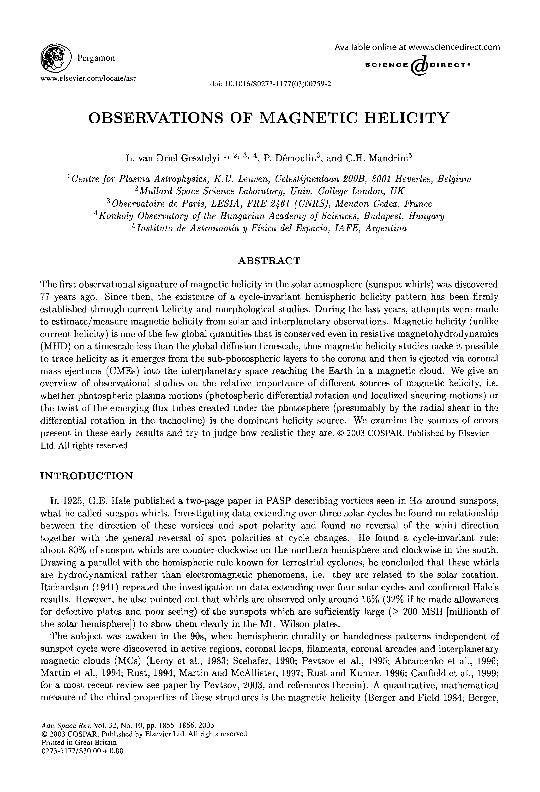Mostrar el registro sencillo del ítem
dc.contributor.author
van Driel Gesztelyi, Lidia

dc.contributor.author
Démoulin, Pascal

dc.contributor.author
Mandrini, Cristina Hemilse

dc.date.available
2017-07-24T18:40:48Z
dc.date.issued
2003-12
dc.identifier.citation
van Driel Gesztelyi, Lidia; Démoulin, Pascal; Mandrini, Cristina Hemilse; Observations of magnetic helicity; Elsevier; Advances in Space Research; 32; 10; 12-2003; 1855-1866
dc.identifier.issn
0273-1177
dc.identifier.uri
http://hdl.handle.net/11336/21183
dc.description.abstract
The first observational signature of magnetic helicity in the solar atmosphere (sunspot whirls) was discovered 77 years ago. Since then, the existence of a cycle-invariant hemispheric helicity pattern has been firmly established through current helicity and morphological studies. During the last years, attempts were made
to estimate/measure magnetic helicity from solar and interplanetary observations. Magnetic helicity (unlike current helicity) is one of the few global quantities that is conserved even in resistive magnetohydrodynamics (MHD) on a timescale less than the global diffusion timescale, thus magnetic helicity studies make it possible
to trace helicity as it emerges from the sub-photospheric layers to the corona and then is ejected via coronal mass ejections (CMES) into the interplanetary space reaching the Earth in a magnetic cloud. We give an overview of observational studies on the relative importance of different sources of magnetic helicity, i.e.
whether photospheric plasma motions (photospheric differential rotation and localized shearing motions) or the twist of the emerging flux tubes created under the photosphere (presumably by the radial shear in the differential rotation in the tachocline) is the dominant helicity source. We examine the sources of errors
present in these early results and try to judge how realistic they are.
dc.format
application/pdf
dc.language.iso
eng
dc.publisher
Elsevier

dc.rights
info:eu-repo/semantics/openAccess
dc.rights.uri
https://creativecommons.org/licenses/by-nc-sa/2.5/ar/
dc.subject
Magnetic Helicity
dc.subject.classification
Astronomía

dc.subject.classification
Ciencias Físicas

dc.subject.classification
CIENCIAS NATURALES Y EXACTAS

dc.title
Observations of magnetic helicity
dc.type
info:eu-repo/semantics/article
dc.type
info:ar-repo/semantics/artículo
dc.type
info:eu-repo/semantics/publishedVersion
dc.date.updated
2017-07-24T14:12:34Z
dc.journal.volume
32
dc.journal.number
10
dc.journal.pagination
1855-1866
dc.journal.pais
Países Bajos

dc.journal.ciudad
Amsterdam
dc.description.fil
Fil: van Driel Gesztelyi, Lidia. Centre National de la Recherche Scientifique. Observatoire de Paris; Francia
dc.description.fil
Fil: Démoulin, Pascal. Centre National de la Recherche Scientifique. Observatoire de Paris; Francia
dc.description.fil
Fil: Mandrini, Cristina Hemilse. Consejo Nacional de Investigaciónes Científicas y Técnicas. Oficina de Coordinación Administrativa Ciudad Universitaria. Instituto de Astronomía y Física del Espacio. - Universidad de Buenos Aires. Facultad de Ciencias Exactas y Naturales. Instituto de Astronomía y Física del Espacio; Argentina
dc.journal.title
Advances in Space Research

dc.relation.alternativeid
info:eu-repo/semantics/altIdentifier/doi/http://dx.doi.org/10.1016/S0273-1177(03)90619-3
dc.relation.alternativeid
info:eu-repo/semantics/altIdentifier/url/http://www.sciencedirect.com/science/article/pii/S0273117703906193
Archivos asociados
